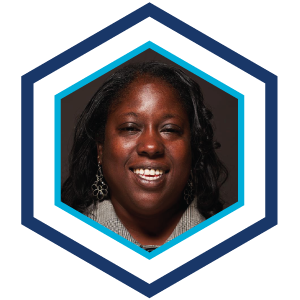The Acronym sat down for an interview with Dr. Adrienne Coleman, the Director of Diversity, Equity, and Inclusion at IMSA. Below are some of the questions discussed with Dr. Coleman regarding her experiences at IMSA as well as her future goals.
Can you tell me about yourself, your background, and how your personal experiences have influenced your passion for promoting inclusivity and diversity at IMSA?
Dr. Coleman has worked in diversity, equity, and inclusion for more than 20 years. She has received a bachelor’s degree in science, a master’s degree in public health, and a doctorate in educational leadership. She later worked in the health and services department at Rutgers University. With her knowledge in the various fields, she came to IMSA and worked with the Council for Campus Equity (CCE) which has become what it has today through Dr. Coleman’s help. Throughout her educational career to where she is today, it is evident that she shows a clear passion for spreading cultural diversity and inclusion for all.
Why is inclusivity important in a high school, and how do you see it shaping the experiences of students and staff?
Dr. Coleman believes that for any individual to thrive, whether it is inside or outside of IMSA, they need to be welcomed, valued, and respected. She believes that these are the rights that any individual should have. High school can be the final step in a student’s educational journey, which means that it is crucial for the students to learn to respect others before being exposed to a more professional environment.
As the Director of Inclusivity, what broad strategies would you employ to foster a more inclusive and accepting high school environment?
The strategies that Dr. Coleman has been following and will continue to align with IMSA’s strategies. She wants to differentiate resources so that every student has access to support and other facilities. She also wants to address the racial and gender gaps that are present at IMSA. She wants to ensure that all students are diverse and that they shouldn’t be afraid to identify as who they are. Along with a diverse group of students, she also hopes that the faculty and staff maintain their diversity. The diversity around campus is what makes IMSA what it is – allowing students to solve problems from different perspectives.
Can you describe your vision for our school’s future with you as the Diversity Coordinator? How do you see it becoming a more inclusive and equitable institution in both policy and daily interactions?
Dr. Coleman believes the IMSA’s Equity and Excellence Policy should guide us on the path to advancing Diversity, Equity, and Inclusion as it forms a positive impact on those who follow it. She wishes that we have an emphasis on centering the voices of our students, especially if they come from a marginalized community. We should also acknowledge the social injustice inside and outside of the walls of IMSA. We should be able to confront these issues as a community. At IMSA, if you were to look at the student community survey, the people who tend to feel the most unsafe were due to issues regarding gender discrimination and racial discrimination. We should learn to accept people for who they are, and together, we need to change the narrative as a community.
Can you share your thoughts on the role of empathy and cultural competency in promoting diversity and equity in an educational setting, and how you would nurture these qualities among students and staff?
She believes that it is very important that we are culturally responsive. Students should see themselves represented in the faculty/staff, curriculum, and walls of the building. People have experienced trauma because of discrimination due to who they are and how they identify. IMSA’s mission is to advance the human condition, and she says that we are not in the right direction if we are discriminating against others due to their identity. It is important that we should be able to create a more safer and inclusive environment for all. As a community, we need to learn to change the mindset that there are certain groups who do not belong here. All of IMSA’s students belong here.
Inclusivity can sometimes face resistance. Can you share an example of a time when you had to persuade others to support inclusivity initiatives, and how did you go about it?
Dr. Coleman likes to share data, like the student diversity survey. Students filled out this survey and results on what IMSA students had issues with were communicated within the Council for Campus Equity. These issues have been worked on by Dr. Coleman and the CCE to tailor a more inclusive environment. She also developed an educational equity impact case that discusses the value of doing work in diversity, equity, and inclusion. She wants to ensure that IMSA’s students are prepared for the outside world. To do that, the students need to learn how to be inclusive and respect others, which will help them embrace multiple perspectives.
In your perspective, why is diversity an important aspect of a school community, and how do you see it contributing to the overall well-being and educational experience of students and staff?
She believes that diversity is a critical aspect of a school community. She tells us that we are living in a diverse world, and being exposed to so many cultures allows us to solve the problems of the world. Solving problems and making the world a more diverse and inclusive place is what we want IMSA students to do.
High schools often have diverse student populations with unique needs. How would you tailor your diversity and equity initiatives to address the challenges at our school?
The best way to deal with the needs of students is by finding issues pertaining to students. There are already online forms, supports, and facilities that students can reach out to which have been implemented with the help of CCE and Dr. Coleman. However, other issues can always arise. Together, we can devise a solution by working with the students to deal with any challenges.
What do you think are some of the changes (in diversity, equity, inclusion) that could be made to IMSA currently to make it a better place for students and staff?
She would like the faculty to show more representation. Having more representation will show a diverse community which is what IMSA is about. She would also like to see more cultural responsiveness of curriculum and services. Having more cultural shows is a great way to spread cultural diversity. Along with this, there could be additional cultural studies and classes with a more comprehensive student education program offered for students. There could also be more people who come to IMSA to teach us about anti-racism and gender sexuality. If these changes were made to IMSA, it would be a more inclusive environment for students and staff.






Be the first to comment on "Getting to know the Director of Diversity, Equity, and Inclusion: Dr. Adrienne Coleman"